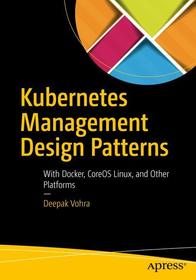
Kubernetes Management Design Patterns
With Docker, CoreOS Linux, and Other Platforms
-
12% KEDVEZMÉNY?
- A kedvezmény csak az 'Értesítés a kedvenc témákról' hírlevelünk címzettjeinek rendeléseire érvényes.
- Kiadói listaár EUR 48.14
-
19 966 Ft (19 015 Ft + 5% áfa)
Az ár azért becsült, mert a rendelés pillanatában nem lehet pontosan tudni, hogy a beérkezéskor milyen lesz a forint árfolyama az adott termék eredeti devizájához képest. Ha a forint romlana, kissé többet, ha javulna, kissé kevesebbet kell majd fizetnie.
- Kedvezmény(ek) 12% (cc. 2 396 Ft off)
- Kedvezményes ár 17 570 Ft (16 733 Ft + 5% áfa)
Kedvezményes ár heti hírlevelünkre feliratkozott ügyfeleinknek.
Iratkozzon fel most és részesüljön kedvezőbb árainkból!
Feliratkozom
Iratkozzon fel most és részesüljön kedvezőbb árainkból!
Feliratkozom
19 966 Ft

Beszerezhetőség
Megrendelésre a kiadó utánnyomja a könyvet. Rendelhető, de a szokásosnál kicsit lassabban érkezik meg.
Why don't you give exact delivery time?
A beszerzés időigényét az eddigi tapasztalatokra alapozva adjuk meg. Azért becsült, mert a terméket külföldről hozzuk be, így a kiadó kiszolgálásának pillanatnyi gyorsaságától is függ. A megadottnál gyorsabb és lassabb szállítás is elképzelhető, de mindent megteszünk, hogy Ön a lehető leghamarabb jusson hozzá a termékhez.
A termék adatai:
- Kiadás sorszáma 1st ed.
- Kiadó Apress
- Megjelenés dátuma 2017. január 29.
- Kötetek száma 1 pieces, Book
- ISBN 9781484225974
- Kötéstípus Puhakötés
- Terjedelem399 oldal
- Méret 254x178 mm
- Súly 7917 g
- Nyelv angol
- Illusztrációk XX, 399 p. 560 illus., 500 illus. in color. Illustrations, black & white 0
Kategóriák
Hosszú leírás:
Take container cluster management to the next level; learn how to administer and configure Kubernetes on CoreOS; and apply suitable management design patterns such as Configmaps, Autoscaling, elastic resource usage, and high availability. Some of the other features discussed are logging, scheduling, rolling updates, volumes, service types, and multiple cloud provider zones.
The atomic unit of modular container service in Kubernetes is a Pod, which is a group of containers with a common filesystem and networking. The Kubernetes Pod abstraction enables design patterns for containerized applications similar to object-oriented design patterns. Containers provide some of the same benefits as software objects such as modularity or packaging, abstraction, and reuse.
CoreOS Linux is used in the majority of the chapters and other platforms discussed are CentOS with OpenShift, Debian 8 (jessie) on AWS, and Debian 7 for Google Container Engine.
CoreOS is the main focus becayse Docker is pre-installed on CoreOS out-of-the-box. CoreOS:
- Supports most cloud providers (including Amazon AWS EC2 and Google Cloud Platform) and virtualization platforms (such as VMWare and VirtualBox)
- Provides Cloud-Config for declaratively configuring for OS items such as network configuration (flannel), storage (etcd), and user accounts
- Provides a production-level infrastructure for containerized applications including automation, security, and scalability
- Leads the drive for container industry standards and founded appc
- Provides the most advanced container registry, Quay
Docker was made available as open source in March 2013 and has become the most commonly used containerization platform. Kubernetes was open-sourced in June 2014 and has become the most widely used container cluster manager. The first stable version of CoreOS Linux was made available in July 2014 and since has become one of the most commonly used operating system for containers.
What You'll Learn
- Use Kubernetes with Docker
- Create a Kubernetes cluster on CoreOS on AWS
- Apply cluster management design patterns
- Use multiple cloud provider zones
- Work with Kubernetes and tools like Ansible
- Discover the Kubernetes-based PaaS platform OpenShift
- Create a high availability website
- Build a high availability Kubernetes master cluster
- Use volumes, configmaps, services, autoscaling, and rolling updates
- Manage compute resources
- Configure logging and scheduling
Who This Book Is For
Linux admins, CoreOS admins, applicationdevelopers, and container as a service (CAAS) developers. Some pre-requisite knowledge of Linux and Docker is required. Introductory knowledge of Kubernetes is required such as creating a cluster, creating a Pod, creating a service, and creating and scaling a replication controller. For introductory Docker and Kubernetes information, refer to Pro Docker (Apress) and Kubernetes Microservices with Docker (Apress). Some pre-requisite knowledge about using Amazon Web Services (AWS) EC2, CloudFormation, and VPC is also required.
Tartalomjegyzék:
Part I Platforms.- 1. Kubernetes On AWS.- 2. Kubernetes on CoreOS.- 3. Kubernetes on Google Cloud Platform. Part 2 Administration and Configuration.- 4. Using Multiple Zones.- 5. Using the Tectonic Console .- 6. Using Volumes.- 7. Using Services.- 8. Using Rolling Updates.- 9. Scheduling Pods.- 10. Configuring Compute Resources.- 11. Using Configmaps.- 12. Setting Resource Quotas.- 13. Using Autoscaling.- 14. Configuring Logging. Part 3 High Availability.- 15. Using a HA Master with OpenShift.- 16. Developing a Highly Available Web Site.




